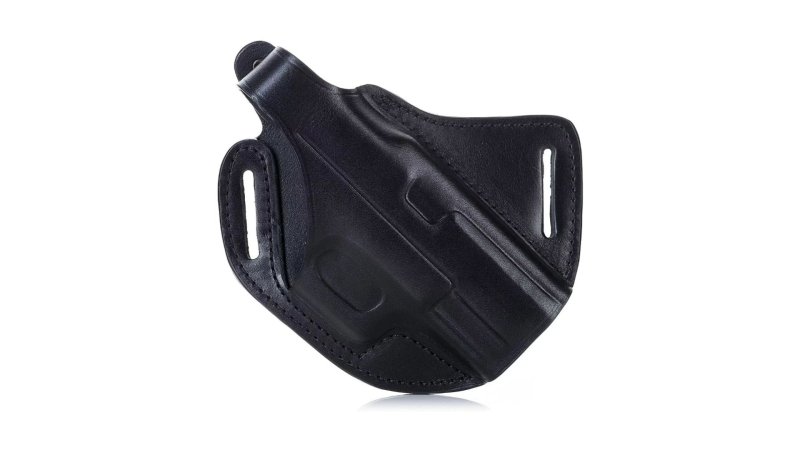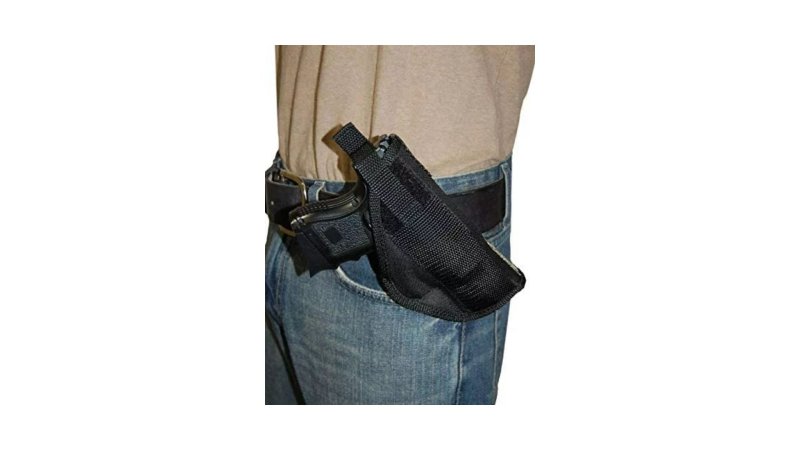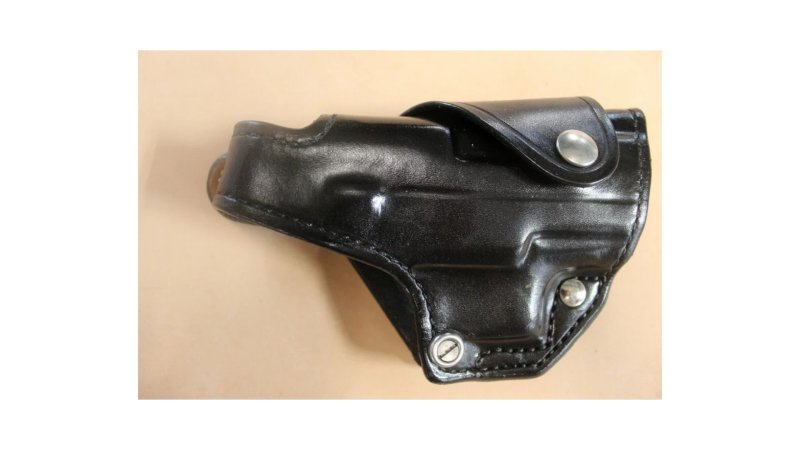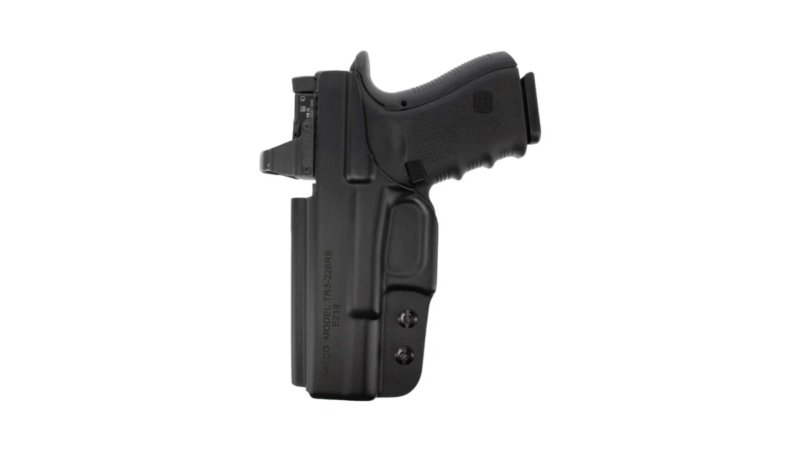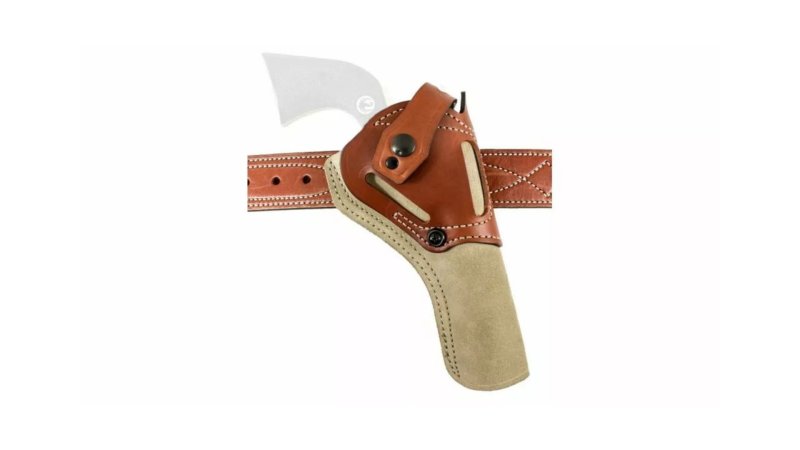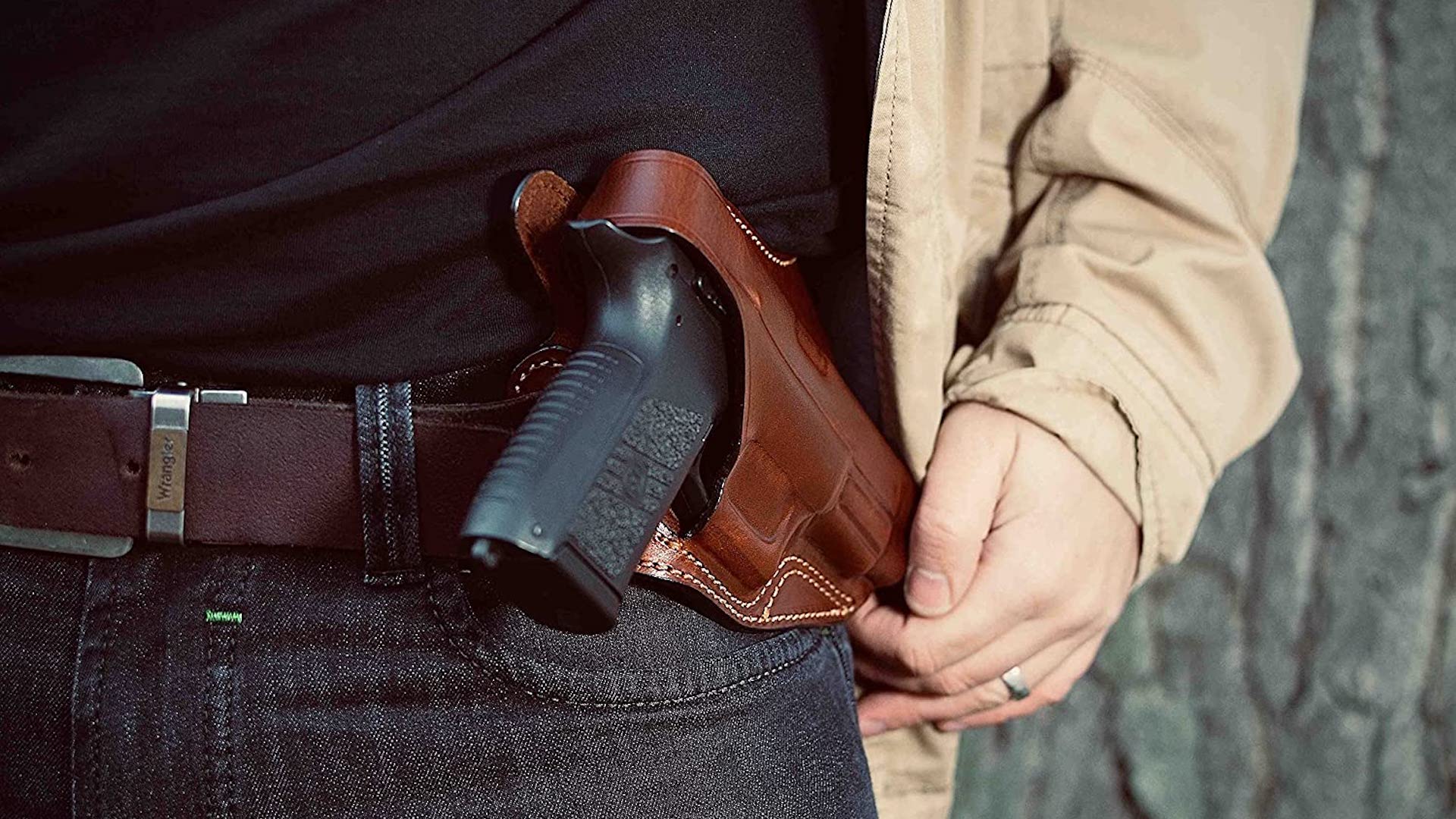

We may earn revenue from the products available on this page and participate in affiliate programs.
Outside of cowboy action shooting, few people wear cross-draw holsters, but that doesn’t mean it’s time for an epitaph just yet. Just as the cowboys and gamblers of the West appreciated the unique advantages a cross-draw holster offered to a man on horseback or seated at a poker table, many modern individuals will appreciate this holster’s ability to provide quick firearm access while seated in a car or at a desk. Whether you prefer open or concealed carry, the cross-draw holster provides easy access to a defensive weapon by positioning your firearm close at hand in virtually any situation. While you may never be Doc Holliday, it’s easy to see why the ailing gambler used such a setup and why maybe you should, too.
Methodology
Cross-draw holsters are a rare find, but they are expected to do the same job as any other holster. As such, I made sure to find holsters that adhered as closely as possible to John Correia’s definition of what makes a good holster. I also hit up the Buckeye Firearms Association, Craft Holsters, Galco, GunDigestTV, hrfunk, JM4 Tactical, and USCCA to supplement what I already knew about cross-draw holsters.
Next, I combed through Amazon, Optics Planet, and other online retailers, as well as YouTube and internet search engines, to find the best holsters I could find. Videos from Gun Talk Media and other outlets were helpful for getting a sense of each offering.
Finally, I watched and read a good number of cross-draw holster reviews to verify (or challenge) my initial findings and to get a better sense of the pros and cons of my final selections. I found GunCollector007, The Maglife Blog, Slim Cowboy, and yankeecowboy to be especially helpful in this regard.
Best Overall
Falco Cross Draw Holster
Pros
- Excellent retention
- High-quality construction
- Great aesthetic
- Compatible with a wide assortment of semi-automatics and revolvers
Cons
- Some models do not completely cover the trigger guard
- Not really a CCW holster
- Not easy to don and doff
Product Specs
- Style: OWB
- Material: Leather
- Retention: Retention strap
Best Value
Barsony New Cross Draw Holster (Compact/Sub-Compact)
Pros
- Very affordable
- Good construction
- Fairly versatile design
Cons
- Somewhat limited firearm compatibility
- Not easy to don and doff
- Angled a bit high
Product Specs
- Style: OWB
- Material: Cordura nylon
- Retention: Retention strap
Editor’s Choice
Andrews Custom Leather Carjacker Crossdraw
Pros
- Great aesthetic
- Adjustable retention
- Easy on and off
- Compatible with a wide assortment of semi-automatics and revolvers
Cons
- Expensive
- Cant angle is a bit low
- Not a good concealed carry holster for large handguns
Product Specs
- Style: OWB
- Material: Leather
- Retention: Friction fit
Best IWB
Galco Triton 3.0
Pros
- Highly customizable fit
- Adjustable tension
- Fits a wide array of sight options
Cons
- Polymer clips may lack durability
- Not a dedicated cross-draw holster
- Only available for Glocks
Product Specs
- Style: IWB
- Material: Kydex
- Retention: Friction fit
Best Single Action Army
DeSantis The Wild Hog
Pros
- Classic style
- Secure, removable retention strap
- Fully ambidextrous
- Reasonable price
Cons
- Does not come pre-molded
Product Specs
- Style: OWB
- Material: Leather
- Retention: Retention strap
Our verdict on cross-draw holsters
Cross-draw holsters may not be the most popular pick anymore, but for those who want one, we think the Falco Cross Draw Holster has got to be the best solution on the block. Its quality, looks, and level of retention are tough to beat, and we love that it’s compatible with all but the most unusual semi-automatics and revolvers. In terms of value, you can’t beat the Barsony New Cross Draw Holster (Compact/Sub-Compact) due to its killer combination of affordability, build quality, and versatility.
What to consider when buying cross-draw holsters
Like with any holster, purchasing a cross-draw holster requires a bit of forethought to avoid wasting money. Of course, the price tag is a noteworthy consideration, but don’t let your budget be your only determining factor. Once you determine whether or not you plan to carry a concealed firearm, investigate the pros and cons of where you will position your holster in relation to your waistband. Also, take the time to evaluate a holster’s key features, such as comfort, stability, retention, and level of comfort.
Types of cross-draw holsters
Outside the waistband (OWB)
The once-popular cross-draw holster was originally designed to be worn on a belt on the outside of your waistband. Outside the waistband (OWB) holsters tend to provide high levels of comfort even with larger semi-autos and revolvers. This also makes them a great choice for anyone who sits for extended periods of time, regularly wears open-front cover garments (like suit jackets), or is going for a Doc Holliday vibe.
One downside to OWB cross-draw holsters is that they can make concealed carry a bit of a hassle for some. Like traditional strong side OWB holsters, the variant of the cross-draw holster absolutely requires a cover garment for concealed carry applications.
Inside the waistband (IWB)
Are you the president of your local Joe Friday fan club but hate the idea of wearing a jacket everywhere you go? If so, then an inside the waistband (IWB) cross-draw holster may be what you need. As the name implies, these holsters position the firearm inside the waist of your pants or shorts, allowing you to carry a concealed firearm without necessarily needing a cover garment. As such, IWB holsters make concealed carrying a cross-drawn rig a whole lot easier.
On the flip side, an IWB cross-draw holster is noticeably less comfortable than an OWB option, and they require a large pant size to accommodate that extra bulk. If you want to avoid printing and a cover garment, then you’ll need to stick with a compact or subcompact handgun for your IWB holster.
Key features of cross-draw holsters
Comfort
In a very real sense, an uncomfortable holster is a useless holster, and cross-draw holsters are no exception. Carrying a self-defense weapon comes with the inherent tradeoff of some degree of discomfort in the form of extra weight, bulk, and sharp corners. That said, a holster that unnecessarily amplifies said discomfort will discourage you from actually carrying your firearm whether you plan to carry it openly or concealed.
Generally, OWB cross-draw holsters will be much more comfortable than IWB options. OWB holsters are best for concealed carry practitioners who don’t mind wearing a cover garment and for individuals who opt for open carry. If streamlined concealed carry is a top priority, an IWB cross-draw holster likely will be your best bet.
Security
Part of responsible firearm ownership is security, and that doesn’t change when you strap on a holster and walk out the door. A quality cross-draw holster will provide good physical security for your firearm using either a good, tight friction fit or, better yet, a retention strap or leather thong. When using a friction fit holster, a firearm-specific holster is non-negotiable, regardless of the construction material.
Another critical consideration is the protection of the trigger guard. Any trigger guard that is not completely covered has the potential to become a liability. Even if your finger can’t reach in there, a smaller one could, so be wary.
Before clicking the “Check Out” button, make sure your choice of cross-draw holster has a solid point of attachment to your clothing. A holster that provides excellent firearm retention but has a cheap clip that won’t close on the hem of your jeans is a waste of money. A quality holster will stay in place draw after draw and hour after hour.
Cross-draw holsters pricing
Cross draw holsters fill a small niche in the holster world, but anyone shopping in that niche is always looking for a great deal. While it may be tempting to snatch up the cheapest holster you can find, don’t do it. Good holsters aren’t cheap, but deciphering between a good deal and a ho-hum offering takes a little effort. To make things easier, we sorted cross-draw holster pricing into bite-sized chunks.
- Under $40: These holsters usually feature cheaper materials and poor to so-so stitching, although you might find one here or there that has decent quality. That said, sub-$40 holsters lack key features, especially in the security department.
- $40 to $80: These are mid-tier holsters and usually employ higher-quality materials and construction. While critical security features are more common, it’s also not uncommon for these holsters to miss one or two.
- Over $80: The best holsters can cost a pretty penny, but the reward is a rig built to the highest standards with the best materials. In this price bracket, you usually will find holsters with all the key security features, but as always, do your research before you buy.
Tips and tricks
As with something you do for decades upon decades, you pick up a few tips and tricks along the way in terms of selecting the right product, and/or using it. That’s the case with us and cross-draw holsters. To help you bridge the information gap, here’s a selection of what we’ve learned along the way.
- Look for a holster that cants your firearm at a steep angle compared to other types of holsters. Due to the biomechanics of a cross draw, a vertically oriented holster will significantly slow your draw.
- As with any holster, make sure you have a belt that can handle the extra weight on your hip.
- If you plan to carry a concealed firearm in a cross-draw holster, seriously consider using a cover garment. IWB cross-draw holsters print relatively easily when the gun is positioned at an angle.
FAQs about cross-draw holsters
You’ve got questions. Task & Purpose has answers
Q: What are the advantages of a cross-draw holster?
A: One of the biggest advantages to a cross-draw holster is the ease of access to your firearm while seated. OWB variants of this holster have the added advantage of handling larger or long-barreled handguns much better than most other concealed carry holsters, provided you wear a cover garment with it.
Q: Is cross-draw slower?
A: It depends. When sitting, a cross draw may just be the fastest option available, but while standing or walking, there might be a couple of faster options, depending on cover garments and muscle memory. No matter what, practice is key.
Q: What side do you wear a cross-draw holster?
A: Cross-draw holsters are designed to be worn on your weak or support side. This means that righties will position their holster on their left hip, while lefties will do the opposite.
Q: What is the most comfortable way to conceal carry?
A: This depends heavily on your physique and lifestyle. People who sit most of the time might prefer an ankle holster, cross-draw, or shoulder holster, while those who stand or walk a lot might prefer an IWB option instead.
Q: What is your strong-side hip?
A: Your strong-side hip is the hip closest to your dominant hand. If you are right-handed, your right hip will be your strong side. If you’re a southpaw, it’ll be your left hip.
